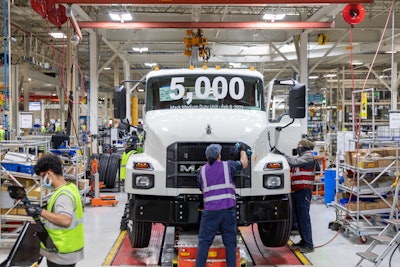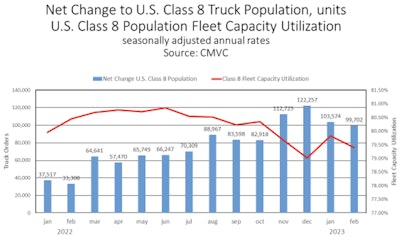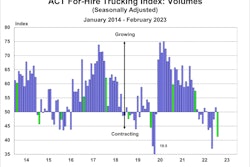
For the fifth time in the last six months, Class 8 truck orders dropped in North America. Preliminary numbers released by FTR Tuesday show 19,000 units were booked in March, down 18% month-over-month and 11% year-over-year.
FTR Chairman Eric Starks said while recent orders have softened, order activity is in line with market expectations and are on pace for an annualized rate of 340,000 units over the last six months.
"With build activity over the last several months hovering near 27,000 units, backlogs likely fell during the month," he added. "Given that backlogs are sitting at such high levels, however, it is difficult to ascertain if there is a fundamental weakening in the Class 8 equipment market given order activity levels."
The incoming order rate for March was 228,000 annualized, right in the sweet spot for replacement demand levels, and Starks said order numbers overall were solid "and will have little impact on production levels over the next two quarters. Given the uncertainty in the economy, this is a welcome sign that demand has not collapsed and that fleets still have access to capital.”
Class 8 orders have totaled 301,500 units over the last 12 months and with nearly all build slots filled for 2023, slower order activity was anticipated. Starks said reduced order levels will likely continue through the normally seasonally weak summer order period. Starks added that fleets continue to request equipment, and quote activity has been in line with past seasonal behavior.
ACT’s Vice President and Senior Analyst Eric Crawford added that given how robust Class 8 orders were into year-end and ensuing backlog support, coupled with increasingly cautious readings from the ACT Class 8 Dashboard, "we have expected [seasonally adjusted] orders in a range of 15,000 to 20,000 units per month into mid Q3’23. After coming in stronger than expected last month, SA Class 8 orders fell back within the 15,000 to 20,000 range, and have averaged 19,500 units [year-to-date]."
Fleet capacity is expanding at faster growth rates than freight volume

U.S. Class 8 fleet capacity utilization has been slowly trending down since June 2022, owed to an increase in heavy truck sales and a sluggish freight environment. While orders were robust for 2022, deliveries of trucks lagged thanks to lingering supply chain snarls. Commercial Motor Vehicle Consulting President Chris Brady estimates pent-up truck demand will be satisfied by the end of the second quarter or early in the third quarter, so fleets must adjust truck investment spending plans during the second half of 2023 or fleet capacity utilization will trend downward to low levels or freight growth must substantially strengthen to support strong truck sales during the second half of the year.
With the likelihood of a soft freight environment at least near-term, Brady said fleets will need to adjust truck investment spending plans, otherwise fleet capacity utilization will trend further downward. If fleet capacity utilization reaches low levels then the adjustments in fleets’ investment spending plans will be swift and large, resulting in large cancellations in truck orders, he said.
"The current rate of Class 8 truck sales is unsustainable for an extended period if the freight environment remains soft, as fleet capacity is expanding at faster growth rates than freight volumes resulting in a downward trend in fleet capacity utilization," he said. "If fleet capacity utilization trends downward to low levels then fleets will be compelled to make swift and large adjustments in truck investment spending plans resulting in large cancellations in Class 8 truck orders. Without an acceleration in freight growth, fleets either make orderly adjustment in truck investment spending plans as fleet capacity utilization trends downward or swift and large adjustments in truck investment spending plans as fleet capacity utilization reaches low levels.”












